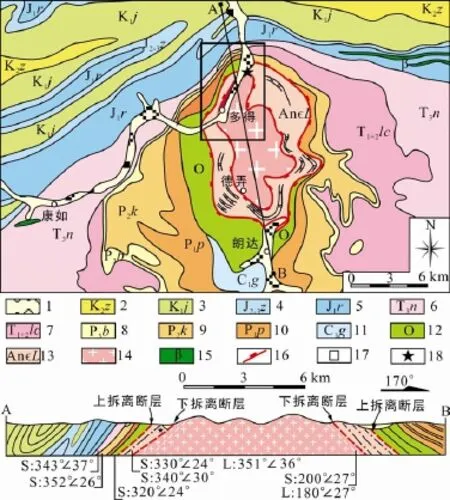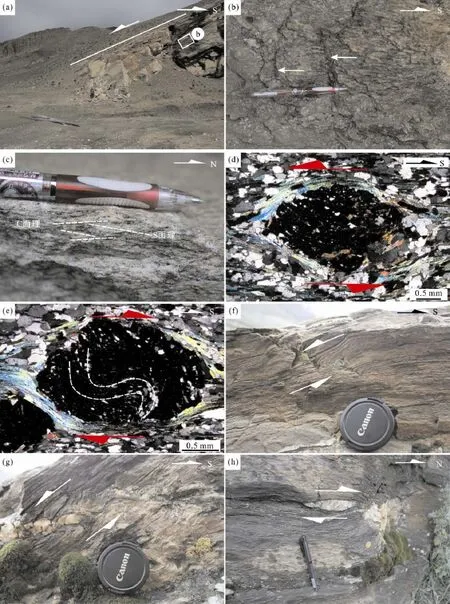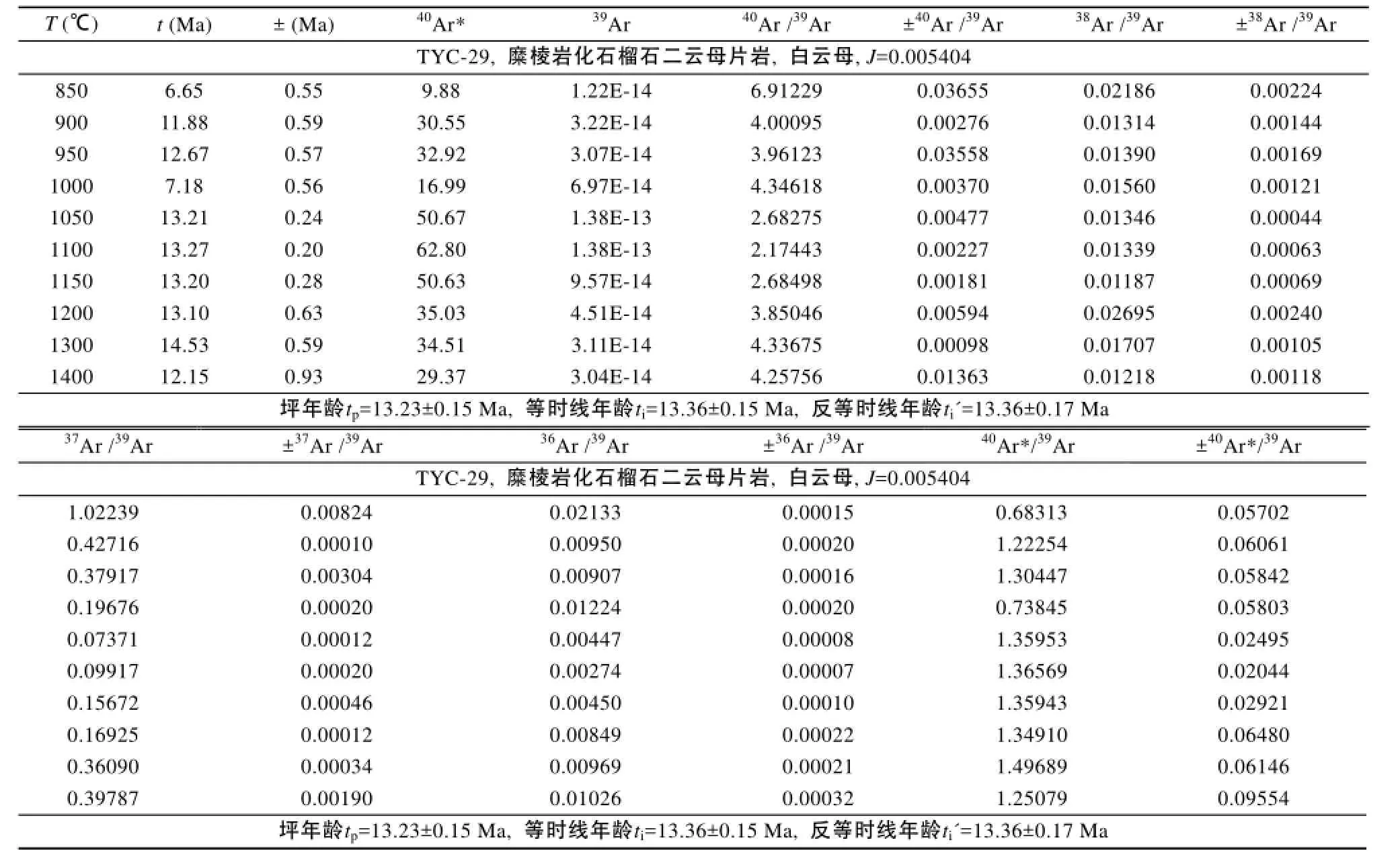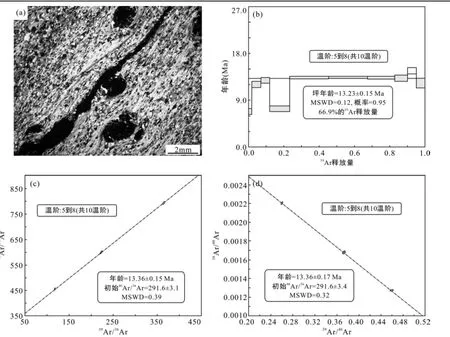藏南康马拆离断层的构造特征及其活动时代
2015-01-19王晓先张进江闫淑玉
王晓先, 张进江, 闫淑玉,, 刘 江,
(1.中国地震局 地壳应力研究所, 地壳动力学重点实验室, 北京 100085; 2.北京大学 地球与空间科学学院,造山带与地壳演化教育部重点实验室, 北京 100871; 3.中国石油勘探开发研究院, 北京 100083; 4.中国地质科学院 地质研究所, 大陆构造与动力学国家重点实验室, 北京 100037)
藏南康马拆离断层的构造特征及其活动时代
王晓先1,2, 张进江2, 闫淑玉2,3, 刘 江2,4
(1.中国地震局 地壳应力研究所, 地壳动力学重点实验室, 北京 100085; 2.北京大学 地球与空间科学学院,造山带与地壳演化教育部重点实验室, 北京 100871; 3.中国石油勘探开发研究院, 北京 100083; 4.中国地质科学院 地质研究所, 大陆构造与动力学国家重点实验室, 北京 100037)
藏南康马穹窿是北喜马拉雅片麻岩穹窿的经典代表, 穹窿内发育上、下两条拆离断层并将穹窿分为三个构造层,其中上拆离断层分隔了上构造层未变质/轻微变质的特提斯喜马拉雅沉积岩系和中构造层的石榴石二云母片岩, 而下拆离断层, 即康马拆离断层, 分隔了中构造层的石榴石二云母片岩和下构造层的片麻状二云母花岗岩。受康马拆离断层的影响, 其上下两盘靠近拆离断层面处的岩石遭受强烈的韧性变形改造, 形成了糜棱岩化石榴石二云母片岩和花岗质糜棱岩, 宏观构造解析以及构造岩的显微构造分析表明, 康马拆离断层经历了上盘向北的伸展拆离。本次研究采用40Ar/39Ar定年方法, 选择拆离断层带内糜棱岩化石榴石二云母片岩中同变形新生白云母进行年代学测定, 结果显示白云母40Ar/39Ar坪年龄为13.23±0.15 Ma, 结合宏微观岩石矿物学分析, 认为其代表了向北伸展拆离的变形时间, 即康马拆离断层的活动时代, 该时代与康马穹窿南部的藏南拆离系的活动时代一致, 从年代学上暗示二者可能为同一条拆离断层, 是在不同区域的出露, 但该结论仍然需要更多地质、地球物理等方面的证据来证实。
藏南; 康马穹窿; 康马拆离断层; 构造特征;40Ar/39Ar定年
0 引 言
始于65~55 Ma (Beck et al., 1995; Rage et al., 1995; Rowley, 1996)的印度–欧亚大陆碰撞–汇聚作用, 形成了世界上最年轻、最典型的碰撞型造山带——喜马拉雅造山带。自新生代以来, 喜马拉雅造山带不仅发生了强烈的岩浆活动, 且在其南北两侧分别经历了以逆冲和伸展为主的变形作用, 二者跨越时间彼此叠置, 构成了复杂的演化过程(王晓先等, 2012; 张进江等, 2013; Zhang et al., 2012), 在此期间形成了南喜马拉雅逆冲推覆体系, 包括主中央逆冲断裂(MCT)、主边界逆冲断裂(MBT)和主前锋逆冲断裂(MFT); 而在北喜马拉雅却发育了多种形式的伸展构造, 如南北向裂谷(NSTR)、藏南拆离系(STDS)和北喜马拉雅片麻岩穹窿(NHGD)等。
强烈碰撞挤压环境中的伸展构造一直是喜马拉雅造山带研究的焦点, 而NHGD是这一伸展构造的典型代表(张进江等, 2007a), 由分布于78°E至92°E之间的一系列片麻岩穹窿组成, 也称北喜马拉雅穹窿带(Yin and Harrison, 2000)或拉轨岗日变质核杂岩带(李德威等, 2003, 2004)。前人对其中交通条件便利的穹窿, 如康马穹窿(Chen et al., 1990; Lee et al., 2000; Wagner et al., 2010)和雅拉香波穹窿(张波等, 2005a, 2005b; 张进江等, 2007)等进行了细致研究,发现穹窿核部花岗岩与外部特提斯喜马拉雅沉积岩系(THS)之间为拆离断层接触关系, 其内构造岩指示向北的伸展拆离, 并认为该拆离断层与STDS有关, 是STDS在THS的出露(张进江等, 2007; Lee et al., 2000, 2004, 2006; Aoya et al., 2006; Lee and Whitehouse, 2007)。虽然前人对穹窿构造进行过深入细致的分析,但是, 对于该拆离断层的特征以及其活动时代仍缺少构造地质和年代学的约束。本文选取拆离断层出露最好的康马穹窿为研究区, 对其北部的康马拆离断层进行详细的构造解析, 结合40Ar/39Ar定年方法, 对拆离断层内糜棱岩化石榴石二云母片岩中同变形新生白云母进行定年, 以期限定拆离断层的伸展变形时间。
1 区域地质背景
狭义的喜马拉雅造山带指雅鲁藏布江缝合带与主前锋逆冲断层(MFT)之间、由新生代印度–欧亚大陆碰撞形成的强烈变形、变质带。该造山带自北向南发育的岩石构造单元依次为THS、STDS、大喜马拉雅结晶杂岩(GHC)、MCT、小喜马拉雅沉积岩系(LHS)、MBT、西瓦里克前陆盆地沉积(SS)和MFT(图1)。其中, 最北部的THS主要由早古生代到始新世经历极低级变质的碎屑岩和碳酸岩组成(Brookfield, 1993; Liu and Einsele, 1999), 在其中部自西向东分布一系列片麻岩穹窿, 为北喜马拉雅伸展构造的重要组成部分(张进江, 2007); GHC位于STDS和MCT之间, 为中高级变质结晶岩系(Aikman et al., 2008),其上部靠近STDS处发育大量的淡色花岗岩, 即STDS花岗岩带(Searle et al., 1997; Harrison et al., 1999; Searle and Godin, 2003; Cottle et al., 2007; Yang et al., 2009; Kellett et al., 2010; Leloup et al., 2010; Liu et al., 2012); LHS位于MCT和MBT之间,由碎屑沉积岩和低级变质岩组成(Brookfield, 1993);最南部为SS, 为一套古近纪–中新世的海相和陆相沉积。 本文的研究区位于喜马拉雅造山带东部的康马穹窿(图1)。
2 康马穹窿的岩石–构造组成
康马穹窿位于康马县城以北, 形态呈椭圆形,穹窿被两条呈环状围绕穹窿出露的拆离断层分成3个岩石单元(图2)。本文将外侧断层称为上拆离断层,内侧断层称为下拆离断层, 也称康马拆离断层(图3a, b), 被它们分隔的3个岩石单元自内向外依次为下构造层片麻状二云母花岗岩, 中构造层中级变质的石榴石二云母片岩和黑云斜长片麻岩, 以及上构造层低级变质和未变质的THS。

图1 喜马拉雅造山带中东段地质简图(据Zhang et al., 2012修改)Fig.1 Sketch geological map of the middle and east section of Himalayan Orogen

图2 康马穹窿地质简图和剖面图(据1:25万江孜县幅地质图修改)Fig.2 Geological map of the Kangmar Dome
2.1 下构造层: 片麻状二云母花岗岩
片麻状二云母花岗岩体位于康马拆离断层下盘的穹窿核部, 岩体南北长11 km, 东西宽3~4 km, 面积达36 km2(刘文灿等, 2004), 片麻状二云母花岗岩发育片麻状构造(图3c), 主要由石英(35%)、钾长石(30%)、斜长石(20%)、黑云母(10%)和白云母(5%)组成(图3d), 其年龄为484~514 Ma (Wang et al., 2012), 暗示早古生代岩浆事件。岩体从中心到边缘,结构有明显变化, 中心相为粗粒结构, 过渡相为中粒结构, 边缘相为细粒结构(夏斌等, 2008), 边缘相遭受拆离断层变形改造, 形成花岗质初糜棱岩(图3e)。花岗质初糜棱岩发育眼球构造, 眼球体主要成分为钾长石, 粒径为0.2~0.5 cm, 线理和面理组构发育, 长石和石英颗粒形成矿物拉伸线理, 定向排列的云母形成透入性面理, 显微镜下可以观察到呈竹节状的石英条带, 条带宽度0.3~0.8 mm不等, 相互平行排列, 定向分布且多与C面理平行(图3f)。在靠近康马拆离断层位置, 部分长英质伟晶岩脉侵入花岗质初糜棱岩, 并切割其糜棱面理(图3g)。 2.2 中构造层: 石榴石二云母片岩和黑云斜长片麻岩
该构造层位于上、下拆离断层之间(图2), 由石榴石二云母片岩和黑云斜长片麻岩组成。石榴石二云母片岩主要矿物组成为白云母、黑云母、石英和大量的石榴石, 石榴石粒径可达0.3~0.5 cm, 岩石遭受变形改造, 发育糜棱组构, 如显微镜下可见S-C组构、石榴石的旋转残斑和压力影构造等(图3h)。石榴石二云母片岩之上为黑云斜长片麻岩, 岩石发生强烈褶皱, 内部出露大量细小的石英脉, 并被强烈变形改造成透镜体(图3i), 显微镜下可见主要矿物包括斜长石、石英和黑云母, 其中黑云母不连续定向排列形成片麻理(图3j)。
2.3 上构造层: 低级变质的THS
该构造层与中构造层界线为上拆离断层, 主要发育奥陶系–三叠系的大理岩、千枚岩、板岩和碎屑沉积岩等, 地层发生强烈的褶皱(王根厚等, 1997)。
3 康马拆离断层的构造特征

图3 康马拆离断层带内岩石野外和显微照片Fig.3 Field outcrops and photomicrographs of the rocks from the Kangmar detachment
本次研究的康马拆离断层是指一宽数十米的变形带, 主要包括下构造层顶部花岗质初糜棱岩、拆离断层面、中构造层底部糜棱岩化石榴石二云母片岩和黑云斜长片麻岩。
3.1 面理和线理
康马拆离断层带内的岩石发育透入性的面理和线理, 但在穹窿的不同部位, 面理和线理产状差异较大。本次的研究区位于康马穹窿的西北部(图2),该区糜棱岩化石榴石二云母片岩的面理产状为330°~340°∠24°~30°, 线理产状为351°∠36°, 呈近南北向展布, 暗示近南北向的运动。
3.2 运动学特征
康马拆离断层在研究区出露平整的拆离断层面(图4a), 断层面上发育密集的擦痕和阶步, 擦痕沿断层面倾向倾伏, 阶步形态指示上盘向北的伸展拆离(图4b)。
康马拆离断层下盘顶部出露花岗质糜棱岩, 其发育透入性的面理和线理, 并可见长石斑晶形成的透镜体(图4c), 但剪切方向不明。
康马拆离断层上盘底部出露中构造层石榴石二云母片岩, 并被糜棱岩化变形所改造, 面理和线理极其发育, 显微镜下可见大量的石榴石旋转残斑,残斑两侧发育压力影构造, 压力影区域主要被石英和黑云母填充(图4d), 残斑形态指示向北的伸展拆离; 部分同构造生长的石榴石变斑晶内发育细小的石英包裹体, 包裹体呈S形螺旋排列, 形成雪球构造(图4e)。糜棱岩化石榴石二云母片岩之上为黑云斜长片麻岩, 其中发育大量轴面向南倒伏的不对称褶皱, 褶皱形态指示上盘向北的伸展(图4f, g); 部分长英质细脉平行于面理分布并被变形改造, 呈现布丁化或透镜体状, 其形态指示了上盘向北的伸展(图4h)。
4 康马拆离断层带构造岩的40Ar/39Ar定年
为了确定康马拆离断层的活动时代, 我们选定拆离断层带内的同变形的糜棱岩化石榴石二云母片岩, 对其内同变形新生白云母进行40Ar/39Ar定年。定年样品采自下拆离断层上盘的最底部(具体采样位置见图2), 样品中白云母定向排列, 形成透入性面理, 其中基质中的白云母颗粒较小, 而石榴石残斑周围的白云母颗粒较大。本研究选择颗粒较大的白云母进行40Ar/39Ar年代学测试。
4.1 测试方法和流程
对样品进行去离子水和丙酮超声波清洗之后,根据样品地质背景估计的年龄和钾含量, 称取20~60 mg, 用纯铝铂纸将0.18~0.28 mm粒径的样品包装成直径约6 mm的球形, 封闭于石英玻璃瓶中,置于中国原子能科学研究院49-2反应堆B4孔道进行中子照射, 照射时间为24 h, 快中子通量为2.2359× 1018ncm–2s–1。用于快中子通量监测的标样是ZBH-25 (132.7 Ma)、Bern 4M (18.6 Ma)、FCs (28.2 Ma)。同时对纯物质CaF2和K2SO4进行同步照射, 得出的校正因子为: (36Ar/37Ar)Ca=0.000271, (39Ar/37Ar)Ca= 0.000652, (40Ar/39Ar)K=0.00703。照射后的样品冷置后, 装入圣诞树状的样品架中, 密封去气72 h以上。样品测试由北京大学造山带与地壳演化教育部重点实验室常规40Ar/39Ar定年系统完成。测定采用钽(Ta)熔样炉对样品进行阶步升温熔样, 每个样品分为10~16步加热释气, 温阶范围为600~1500 ℃, 每个加热点在恒温状态下保持20 min。系统分别用活性炭冷井及锆钒铁吸气剂炉对气体进行纯化, 活性炭冷井的纯化时间为10 min, 锆钒铁吸气剂炉的纯化时间为15 min。使用RGA10型质谱仪记录五组Ar同位素信号, 信号强度以毫伏(mV)为单位记录, 质谱峰循环测定9次。数据处理时, 采用该实验室编写的40Ar/39Ar Dating 1.2数据处理程序对各组Ar同位素测试数据进行校正计算, 再采用Isoplot 3.0(Ludwig, 2003)计算坪年龄及等时线年龄。
4.2 测试结果
本次研究对糜棱岩化石榴石二云母片岩(TYC-29)中白云母进行测试, 测试结果列于表1。从图5b中可以看出, 白云母在850~1400 ℃之间的4个加热阶段析出的39Ark累计为66.9%, 给出一个稳定的坪年龄为13.23±0.15 Ma (MSWD=0.95) (图5b), 等时线和反等时线年龄分别为13.36±0.15 Ma (MSWD= 0.39) (图5c)和13.36±0.17 Ma (MSWD=0.32) (图5d),与坪年龄基本一致。白云母的初始40Ar/36Ar为291.6,略低于尼尔值295.5, 表明存在Ar丢失, 但程度极低, 因此认为该年龄数据是可靠的。
5 康马拆离断层带白云母40Ar/39Ar年龄的地质意义

图4 康马拆离断层带内构造岩运动学特征Fig.4 Kinematic characteristics of the tectonites from the Kangmar detachment zone

表1 糜棱岩化石榴石二云母片岩同变形新生白云母40Ar/39Ar年龄分析数据Table 140Ar/39Ar dating data for analyzed new-born syn-deformation muscovite from mylonitic garnet two-mica schist

图5 康马拆离断层40Ar/39Ar定年样品显微照片(a)及坪年龄(b)、等时线年龄(c)和反等时线年龄(d)Fig.5 Photomicrograph (a),40Ar/39Ar plateau age (b), isochron age (c) and inverse isochron age (d) for the sample from the Kangmar detachment
定年样品(TYC-29)的宏微观构造观察发现, 其原岩被强烈的韧性变形改造为糜棱岩化石榴石二云母片岩, 发育大量同变形的石榴石旋转残斑, 用于40Ar/39Ar测年的大颗粒白云母主要分布在同变形石榴石残斑周围(图5a), 并向外延伸平行于基质面理,且其与石榴石旋转残斑组成的不对称构造指示向北的伸展拆离, 表明这些大颗粒的白云母应该是同伸展变形的产物。石榴石压力影区域由石英和少量黑云母组成, 石英主要以波状消光和膨凸重结晶为主(图3h和图4d, e), 暗示伸展变形温度在280~350 ℃之间(Stipp et al., 2002), 这个温度等于或低于白云母的40Ar/39Ar封闭温度(350 ℃), 在这样的温度下白云母的40Ar/39Ar冷却年龄可能与变形年龄一致(Reddy and Potts, 1999)。因此, 康马拆离断层向北伸展拆离的时间约为13.23±0.15 Ma。
NHGD拆离断层(或剪切带)与STDS具有相似的岩石组成和构造特征(张进江等, 2007), 暗示NHGD拆离断层可能是STDS向北向下延伸的部分,后期由于岩浆底辟和剥蚀作用而出露于THS, 这一结论也得到了地球物理资料的证实(Brown et al., 1996; Nelson et al., 1996)。如果上述成立, 那么NHGD拆离断层与STDS应该具有相同的活动时代,与本文研究区康马拆离断层相对应的是其南部西不丹地区的STDS, 前人研究发现, 西不丹Masang Kang地区STDS活动时代为15.5~11.0 Ma (Kellett et al., 2009), Khula Hangri地区STDS活动时代为12.5 Ma (Edwards and Harrison, 1997), 与康马拆离断层的活动时代(13.23±0.15 Ma)一致, 从年代学上暗示康马拆离断层与STDS可能为同一条拆离断层, 但该假设仍需要更多来自地质、地球物理等方面的证据来证实。
6 结 论
康马拆离断层是分隔康马穹窿下构造层片麻状二云母花岗岩和中构造层中高级变质岩的一条重要的地质界线, 其内构造岩宏–微观构造特征指示了上盘向北的伸展拆离, 同变形新生白云母40Ar/39Ar年龄限定其向北伸展拆离的时间为13.23±0.15 Ma,与南部STDS活动时代一致, 从年代学上暗示二者可能为同一条拆离断层在不同区域的出露, 但该结论仍需更多的地质和地球物理等方面的证据支持。
致谢:年代学测试和数据处理得到北京大学季建清副教授的指导和帮助, 论文修改过程中两位审稿人给予了宝贵的意见, 在此一并感谢。
李德威, 刘德民, 廖群安, 张雄华, 袁晏明. 2003. 藏南萨迦拉轨岗日变质核杂岩的厘定及其成因. 地质通报, 22(5): 303–307.
李德威, 张雄华, 廖群安, 袁晏明, 易顺华, 曹树钊, 谢德凡, 刘德民. 2004. 定结县幅、陈塘区幅地质调查新成果及主要进展. 地质通报, 23(6): 438–443.
刘文灿, 王瑜, 张祥信, 李惠民, 周志广, 赵兴国. 2004.西藏南部康马岩体岩石类型及其同位素测年. 地学前缘, 11(4): 491–501.
王根厚, 周详, 曾庆高, 普布次仁. 1997. 西藏康马热伸展变质核杂岩构造研究. 成都理工学院学报, 24(2): 62–67.
王晓先, 张进江, 刘江, 闫淑玉, 王佳敏. 2012. 中新世中期喜马拉雅造山带构造体制的转换. 科学通报, 57(33): 3162–3172.
夏斌, 徐力峰, 张玉泉, 李建峰, 王彦斌. 2008. 西藏南部康马花岗岩锆石SHRIMP U-Pb年龄. 矿物岩石, 28(3): 72–76.
张波, 张进江, 郭磊, 王维亮. 2005a. 北喜马拉雅穹窿带雅拉香波变质核杂岩拆离断层系中糜棱岩带构造特征及变形分析. 自然科学进展, 15(6): 692–699.
张波, 张进江, 郭磊. 2005b. 雅拉香波穹窿韧性剪切带变形特征与剪切作用类型研究. 新疆地质, 23(1): 4–9.
张进江. 2007. 北喜马拉雅及藏南伸展构造综述. 地质通报, 26(6): 639–649.
张进江, 郭磊, 张波. 2007. 北喜马拉雅穹窿带雅拉香波穹窿的构造组成和运动学特征. 地质科学, 42(1): 16–30.
张进江, 王佳敏, 王晓先, 张波. 2013. 喜马拉雅造山带造山模式探讨. 地质科学, 48(2): 362–383.
中国地质大学(北京). 中华人民共和国地质图1:25万江孜县幅(H45C004004).
Aikman A B, Harrison T M and Ding L. 2008. Evidence for early (>44 Ma) Himalayan crustal thickening, Tethyan Himalaya, southern Tibet. Earth and Planetary Science Letters, 274: 14–23.
Aoya M, Wallis S R, Kawakami T, Lee J, Wang Y and Maeda H. 2006. The Malashan gneiss dome in south Tibet: Comparative study with the Kangmar dome with special reference to kinematics of deformation and origin of associated granites. Geological Society, London, Special Publication, 268: 471–495.
Beck R A, Burbank D W, Sercombe W J, Riley G, Barndt J K, Berry J R, Afzal J, Khan A M, Jurgen H, Metje J, Cheema A, Shafique N A, Lawrence R D and Khan M A. 1995. Stratigraphic evidence for an early collision between Northwest India and Asia. Nature, 373: 55-58.
Brookfield M E. 1993. The Himalayan passive margin from Precambrian to Cretaceous. Sedimentary Geology, 84: 1–35.
Brown L D, Zhao W J, Nelson K D, Hauck M, Alsdorf D,Ross A, Coqan M, Clark M, Liu X and Che J. 1996. Bright spots, structures, and magmatism in southern Tibet from INDEPTH seismic reflection profiling. Science, 274: 1688–1690.
Chen Z, Liu Y, Hodges K V, Burchfiel B C, Royden H and Deng C. 1990. The Kangmar dome: A metamorphic core complex core in Southern Xizang (Tibet). Science, 250: 1552–1556.
Cottle J M, Jessup M J, Newell D L, Searle M P, Law R D and Horstwood M S A. 2007. Structural insights into the early stages of exhumation along an orogen-scale detachment: The South Tibetan detachment system, Dzakaa Chu section, eastern Himalaya. Journal of Structural Geology, 29: 1781–1797.
Edwards M A and Harrison T M. 1997. When did the roof collapse? Late Miocene north-south extension in the high Himalaya revealed by Th-Pb monazite dating of the Khula Kangri granite. Geology, 25: 543–546.
Harrison T M, Grove M, Mckeegan K D, Coath C D, Lovera O M and Le Fort P. 1999. Origin and episodic emplacement of the Manaslu intrusive complex, central Himalaya. Journal of Petrology, 40: 3–19.
Kellett D A, Grujic D and Erdmann S. 2009. Miocene structural reorganization of the South Tibetan detachment, eastern Himalaya: Implications for continental collision. Lithophere, (1): 259–281.
Kellett D A, Grujic D, Warren C, Cottle J, Jamieson R and Tenzin T. 2010. Metamorphic history of a syn-convergent orogen-parallel detachment: The South Tibetan detachment system, Bhutan Himalaya. Journal of Metamorphic Geology, 28: 785–808.
Lee J, Dinklage B R, Dinklage W S, Wang Y, Gans P, Calvert A, Wan J L, Chen W J, Blythe A E and McClelland W. 2000. Evolution of the Kangmar Dome, southern Tibet: Structural, petrologic, and thermochronologic constrains. Tectonics, 19: 872–895.
Lee J, Hacker B and Wang Y. 2004. Evolution of North Himalayan gneiss domes: Structural and metamorphic studies in Mabja Dome, southern Tibet. Journal of Structural Geology, 26: 2297–2316.
Lee J, McClelland W, Wang Y, Blythe A and McWilliams M. 2006. Oligocene-Miocene middle crustal flow in southern Tibet: Geochronology of Mabja Dome. Geological Society, London, Special Publications, 268: 445–469.
Lee J and Whitehouse M J. 2007. Onset of mid-crustal extensional flow in southern Tibet: Evidence from U/Pb zircon ages. Geology, 35: 45–48.
Leloup P H, Mahèo G, Arnaud N, Kali E, Boutonnet E, Liu D Y, Liu X H and Li H B. 2010. The South Tibet detachment shear zone in the Dinggye area: Time constraints on extrusion models of the Himalayas. Earth and Planetary Science Letters, 292: 1–16.
Liu G and Einsele G. 1999. Jurrassic sedimentary facies and paleogeography of the former Indian passive margin in southern Tibet. GSA Special Papers, 328: 75–108.
Liu X B, Liu X H, Leloup P H, Maheo G, Paquette J L, Zhang X G and Zhou X J. 2012. Ductile deformation within Upper Himalaya Crystalline Sequence and geological implications, in Nyalam area, Southern Tibet. Chinese Science Bulletin, 57: 3469–3481.
Ludwig K R. 2003. ISOPLOT 3.0: A Geochronological Toolkit for Microsoft Excel. Berkeley Geochronology Center Special Publication, 4: 1–71.
Nelson K D, Zhao W J, Brown L D, Kuo J, Che J, Liu X, Klemperer S L, Mokovsky Y, Meissner R, Mechie J, Kind R, Wenzel F, Ni J, Nabelek J, Leshou C, Tan H, Wei W, Jones A G, Booker J, Unsworth M, Kidd W S F, Hauck M, Alsdorf D, Ross A, Coqan M, Wu C, Sandvol E and Edwards M. 1996. Partially molten middle crust beneath southern Tibet: Synthesis of Project INDEPTH results. Science, 274: 1684–1688.
Rage J C, Cappetta H, Hartenberger J L, Jaeger J J, Sudre J, Vianey-liaud M, Kumar K, Prasad G V R and Sahni A. 1995. Collision ages. Nature, 375: 286.
Reddy S M and Potts G J. 1999. Constraining absolute deformation ages: The relationship between deformation mechanism and isotope sysmatics. Journal of Structural Geology, 21: 1255–1265.
Rowley D B. 1996. Age of initiation collision between India and Asia: Review of the stratigraphic data. Earth and Planetary Science Letters, 145: 1–13.
Searle M P and Godin L. 2003. The South Tibetan Detachment system and the Manaslu leucogranite: A structural re-interpretation and restoration of the Annapurna Manaslu Himalaya, Nepal. Journal of Geology, 111: 505–523.
Searle M P, Parrish R R, Hodges K V, Hurford A, Ayres M W and Whitehouse M J. 1997. Shisha Pangma leucogranite, south Tibetan Himalaya: Field relations, geochemistry, age, origin, and emplacement. Journal of Geology, 105: 295–317.
Stipp M, Stunitz H, Heilbronner R and Schmid S M. 2002. Dynamic recrystallization of quartz: Correlation between natural and experimental condition. Geological Society, London, Special Publications, 200: 171–190.
Wagner T, Lee J, Hacker B R and Seward G. 2010. Kinematics and vorticity in Kangmar Dome, southern Tibet: Testing midcrustal channel flow models for the Himalaya. Tectonics, 29: TC6011.doi: 10.1029/2010TC002736.
Wang X X, Zhang J J, Santosh M, Liu J, Yan S Y and Guo L. 2012. Andean-type orogeny in the Himalayas of south Tibet: Implications for early Paleozoic tectonics along the Indian margin of Gondwana. Lithos, 154: 248–262.
Yang X Y, Zhang J J, Qi G W, Wang D C, Guo L, Li P Y and Liu J. 2009. Structure and deformation around the Gyirong basin, northern Himalaya, and onset of the south Tibet detachment system. Science in China (Series D), 52: 1046–1058.
Yin A and Harrison T M. 2000. Geologic evolution of the Himalayan Tibetan orogen. Annual Review of Earth and Planetary Sciences, 28: 211–280.
Zhang J J, Santosh M, Wang X X, Guo L, Yang X X and Zhang B. 2012. Tectonics of the northern Himalaya since the India-Asia collision. Gondwana Research, 21: 939–960.
Structural Characteristics and Active Time of the Kangmar Detachment, Southern Tibet
WANG Xiaoxian1,2, ZHANG Jinjiang2, YAN Shuyu2,3and LIU Jiang2,4
(1. Key Laboratory of Crustal Dynamics, Institute of Crustal Dynamics, China Earthquake Administration, Beijing 100085, China; 2. MOE Key Laboratory of Orogenic Belts and Crustal Evolution, School of Earth and Space Sciences, Peking University, Beijing 100871, China; 3. Petroleum Exploration and Development Research Institute, PetroChina, Beijing 100083, China; 4. State Key Laboratory of Continental Tectonics and Dynamics, Institute of Geology, Chinese Academy of Geological Sciences, Beijing 100037, China)
The Kangmar gneiss dome, typical of the north Himalayan gneiss domes, is composed of three tectonolithologic units separated by an upper and a lower detachment fault (Kangmar detachment fault). The low-grade metamorphic Tethyan Himalayan sedimentary sequence formed the upper unit above the brittle upper detachment fault. The mylonitic granites and two-mica granites made up the lower unit beneath the ductile lower detachment fault. The mylonitc middle-grade garnet two-mica schist and biotite-plagioclase gneiss constituted the middle unit inbetween the two detachment faults and were involved in the ductile deformation of the Kangmar detachment fault. The meso- and micro-scale structural analyses on the tectonites from the detachment fault zone indicated that the Kangmar detachment fault experienced a top-down-to-north shear. Integrating macro-/micro-analyses of petrology and mineralogy, this study adopts40Ar/39Ar dating method to constrain the active time of the Kangmar detachment fault. Analyses of the syn-deformation muscovite from the mylonitic garnet two-mica schist yield a40Ar/39Ar plateau age of 13.23±0.15 Ma, representing the active time of the Kangmar detachment fault. The chronological result hints that the Kangmar detachment was synchronous with the south Tibet detachment systems to the south and was probably part of the south Tibet detachment systems exposed in the Tethyan Himalayan sedimentary sequence. However, this hypothesis needs from the supports of more geological and geophysical evidence.
southern Tibet; Kangmar Dome; Kangmar detachment; structural characteristics;40Ar/39Ar dating
P542
A
1001-1552(2015)02-0250-010
2014-03-24; 改回日期: 2015-01-07
项目资助: 中国地震局地壳应力研究所中央级公益性科研院所基本科研业务专项(编号: ZDJ2014-09)和国家自然科学基金(批准号: 41402175, 41172176)资助。
王晓先(1986–), 男, 博士, 助理研究员, 从事构造地质学研究工作。Email: xiaoxianwang@pku.edu.cn
